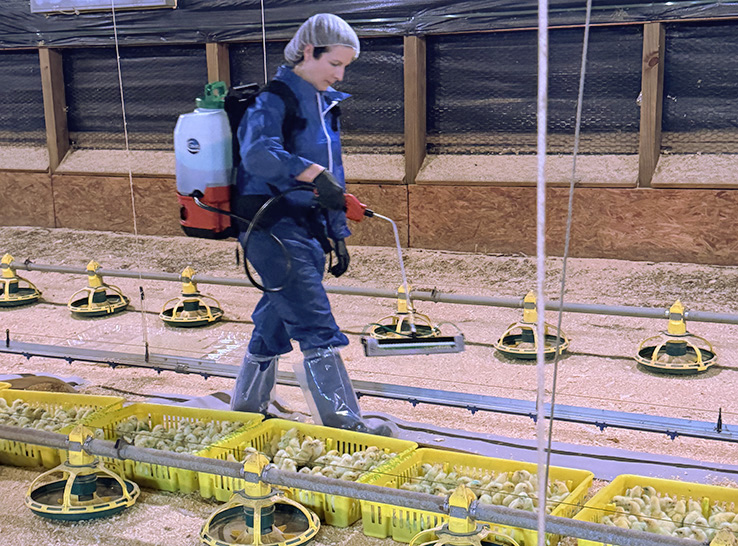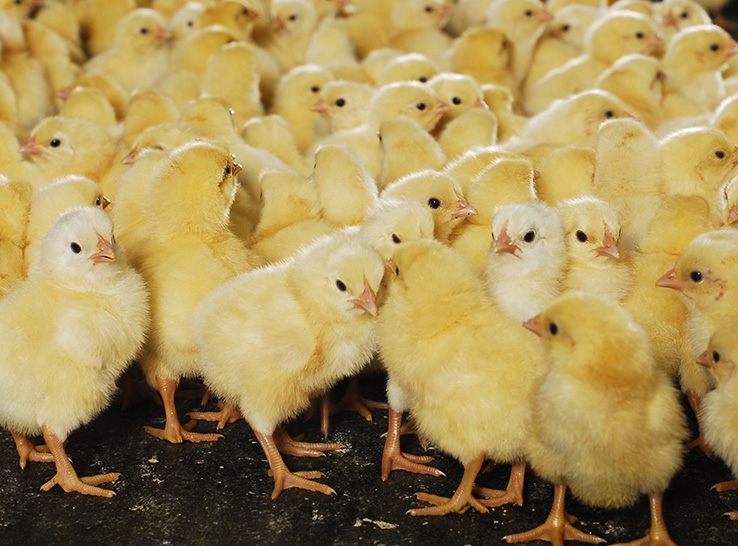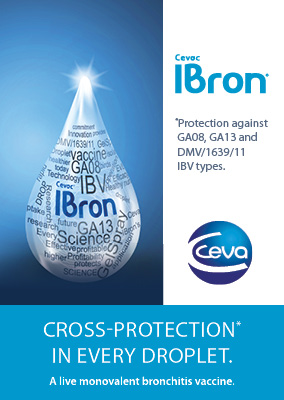A new vaccine-application approach shows advantages to help make on-farm, day-of-age vaccination easier to perform while increasing effectiveness.
Research shows using new technology to administer vaccines via gel droplets leads to faster administration and higher vaccination uptake. This ultimately boosts flock disease protection, according to Kelli Jones, DVM, MAM, diplomate ACPV, at Ceva Animal Health.
“We have found that 100% vaccine uptake is not uncommon with this approach. It has the potential to become a preferred option for poultry farms to ensure flock health and economic performance,” Jones said when presenting her data at the 2024 American Association of Avian Pathologists meeting.
Strengthening protection
Vaccination programs for chicks and poults have included a strong focus on activity at the hatchery level. For all types of vaccines applied at the hatchery, a small percentage of birds are at risk of not ingesting an adequate amount of vaccine. Chick and poult fitness at the time of vaccination can be compromised, which lowers the effectiveness of vaccines.
“At the hatchery, the birds are often inactive and tired from having gone through the hatch process and servicing procedures,” Jones explained. “This can make them less fit to uptake applied vaccines that require ingestion. If a poult or chick is not interested in preening or is not stimulated to preen, this can reduce the uptake.”
This is often due to reduced interest, especially for the long-lived type birds that lack hybrid vigor like broilers have, she said.
There are additional limitations to hatchery vaccination programs, she noted. For instance, hatchery operators are often reluctant to vaccinate for variant strains of infectious bronchitis (IB) that may not be needed universally. They also often limit the administration of live vaccines, such as bacterial vaccines for Salmonella or Escherichia coli. This may be due to their reluctance to introduce these agents into the hatchery environment.
Shifting focus to on-farm
Producers fill gaps in vaccination programs by shifting administration to the farm.
“During the period that chicks and poults are transported from the hatchery to the farm, they have time to rest and recover from the inherent stresses of hatching and processing. The trucks are very comfortable and provide ideal conditions for the birds,” Jones said.
“By the time they arrive at the farm, they are more fit, more attentive and more interested in preening. As a result, they are more responsive to ingest applied vaccines.”
Gel droplet versus water spray
Vaccines are administered at the time of placement, traditionally via a water-spray application. One possible alternative to this is to administer the vaccines in gel droplets. This can be done with either a hand pump-up sprayer or a specially designed applicator, such as Ceva’s new gel-bar technology.
Jones says there are three major advantages to using gel-drop vaccines versus traditional spray applications.
First, using gel droplets avoids wetting and chilling the birds. That’s important because chicks and poults are at a stage of development where they have difficulty regulating body temperature. Wetting and chilling birds with water-spray vaccines can negatively affect their health and well-being. Because the gel droplets remain on top of the down, birds stay dry and warm.
Second, gel-droplet formulations allow for higher volumes of product to be administered to each box of birds, allowing for greater coverage and effectiveness. Removing the risk of over-wetting or chilling the birds means an optimal amount of vaccine can be applied.
Third, gel droplets stimulate greater bird attention and are more attractive to ingest versus water-spray-applied vaccines. “The gel beads are highly visible, attracting birds to them, instantly leading to a high level of consumption,” Jones said.
These advantages result in higher uptake of the vaccine during day-of-age vaccination, Jones said. “We have found that on-farm vaccination using gel droplets is an effective way to prevent the small percentage of birds that otherwise might be missed with traditional hatchery or on-farm water sprays.”
Jones and her colleagues are not advocating for reduced vaccination activity at the hatchery, she emphasized. “The key improvement we’re recommending is to add activity on-farm as insurance,” she added.
“Overall, on-farm vaccine approaches can be fine-tuned as much as the local veterinarian and producer would like, even down to the flock-by-flock level.”
If producers add one type of on-farm vaccination, the door is open to administering other vaccines efficiently at the same time, she noted. “We’ve seen approaches where applications that would otherwise be done later in life can be done as well at day of age,” she said.
Evolving best practices
It’s best to administer gel vaccines while the birds are clustered in the boxes, according to Jones. This makes it easier to ensure better coverage of the vaccine. Usually, the poultry company’s service technicians take this on as one of their placement duties, Jones noted.
Jones said broiler breeder pullets are normally given a Salmonella vaccine on-farm at day of age, usually applied via a hand-pump water-spray applicator. Pullets may also be offered some sort of other day-of-age water-spray vaccine at placement — often a bronchitis vaccine.
Some vaccines, such as coccidiosis, should still be initially applied at the hatchery. Adding a gel-droplet option could provide the additional coverage often required on the farm. This is another instance where chicks may not have been inclined at the hatchery but are more fit for uptake on the farm.
Hand-pump spray versus new gel applicator
Shifting to gel-droplet application provides other options and benefits.
“With gel vaccines, you can still use the same hand pump-up spray applicator you would use for a water-spray vaccine,” she said. “Often the only change needed is to select the gel-application option, instead of a water-spray option.”
New gel applicator
A potentially better approach, she said, is to use a customized gel-droplet applicator designed by Ceva for on-farm use.
“With this applicator, we apply a gel bar directly to the wand, so there is no pump-up activity needed. It’s a battery-powered backpack sprayer that applies continuous pressure to the gel bar. This allows you to just walk continuously over the birds, saving both time and effort,” she explained.
The time savings is significant, she said, allowing for application at a “nice, steady pace,” requiring only 1 to 3 seconds per box (versus 3 to 5 seconds with a hand pump-up sprayer).
“In the video, you can see these birds really become stimulated once they feel the droplets on them, and they immediately start consuming these droplets,” she added. (See accompanying video.)
Evaluation of vaccine ‘takes’
Gel droplets should be consumed within 3 to 5 minutes of application, Jones said. Typically, 100% of the birds in the boxes have a tongue that reflects the vaccine dye color 5 minutes post-vaccination. “To evaluate uptake, you can check this by looking at the tongues; they will be a nice color based on the color of dye used in the vaccine.”
In testing using the new custom applicator, the approach was so effective that within a few minutes they could also clearly see no remaining gel beads in each tray.
Jones presented performance data from IB and coccidiosis vaccines. The evaluation reviewed respiratory takes at 7 days and oocysts-per-gram (OPG) curves. “We saw nice positive OPG counts at 7 days and very uniform IB qRT-PCR takes,” she added.
Results showed substantial improvements in OPGs for on-farm gel-vaccinated birds versus those vaccinated only at the hatchery, Jones said.
IB vaccines have also been evaluated using molecular analysis at 7 days. Jones showed results evaluating IBron, a live monovalent bronchitis vaccine containing a Georgia serotype of IB, which showed 100% uptake.
“We see this time and time again,” she reported. “And this is greatly improved compared to what we see using a water spray. It’s repeatable that the uptake is superior with the gel application.”
The team hasn’t tested bacterial vaccines yet using the new gel bar. However, Jones feels that there is no reason not to believe uptake results would be just as good.
With positive results such as these, Jones is encouraged that on-farm day-of-age gel-droplet vaccination using the novel applicator has strong potential for the future. “The uniformity of the birds’ immune response to disease depends on a consistently high standard of vaccination. That’s what this new approach delivers.”
Editor’s note: Content on Modern Poultry’s Industry Insights pages is provided and/or commissioned by our sponsors, who assume full responsibility for its accuracy and compliance.







